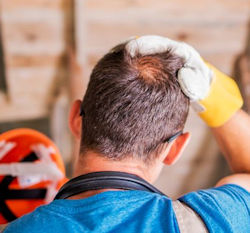Head, Hand, and Foot Protection
Head Protection
Protecting employees from potential head injuries is an important goal. A head injury can lead to lifelong impairment or even be fatal.
Wearing a safety helmet or hard hat is one of the easiest ways to protect an employee's head from injury. Hard hats can protect employees from impact and penetration hazards as well as from electrical shock and burn hazards. Workers who fall from heights often suffer severe head injuries because they lose their hard hats, typically due to not using chin straps.
Employers must ensure that their employees wear head protection if any of the following apply:
- Objects might fall from above and strike them on the head.
- They might bump their heads against fixed objects, such as exposed pipes or beams.
- There is a possibility of accidental head contact with electrical hazards.
Falling Objects
When there is a risk of head injury from falling objects at work, the employer must ensure every affected employee wears a protective helmet.
Some examples of work that might require helmets to protect from falling objects include:
- Working below other workers who are using tools and materials which could fall.
- Working around or under conveyor belts which are carrying parts or materials.
- Working below machinery or processes which might cause material or objects to fall.
Electrical Hazards
The second situation requiring a helmet is to protect the worker from electrical hazards. Whenever an employee works near exposed electrical conductors which could contact the head, the employer must make sure that a protective helmet designed to reduce electrical shock hazard is worn by the employee.
Employers must provide and ensure that all employees and contractors involved in construction and other tasks wear appropriate head protection. Additionally, engineers, inspectors, and visitors at construction sites need to wear protective helmets when there's a risk of falling objects, collision with fixed objects, or electrical shock.
Knowledge Check Choose the best answer for the question.
5-1. Employees must wear protective helmets in which of the following situations?
You forgot to answer the question!

